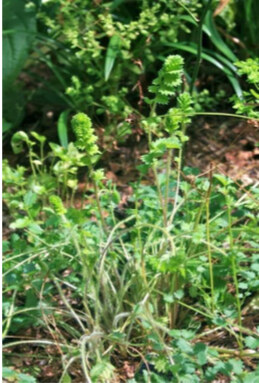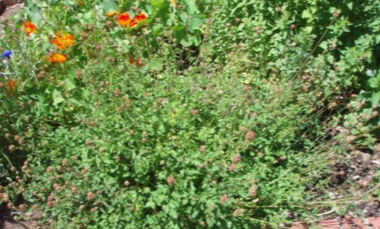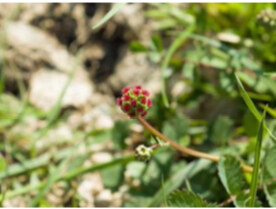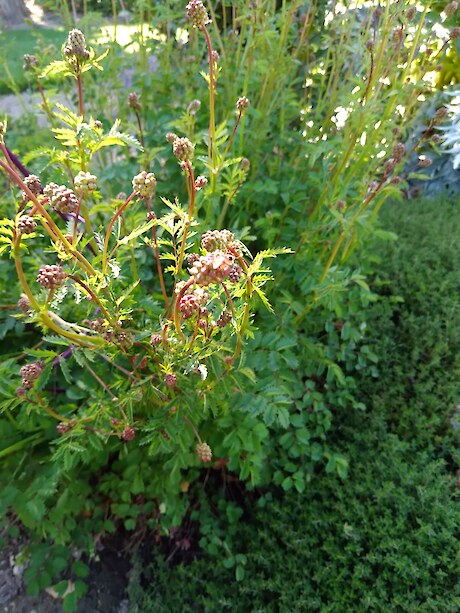Sanguisorba minor/Poterium sanguisorba
Download info sheetThis ‘old fashioned herb’, Salad Burnet has the botanical name of Sanguisorba minor; it has been renamed Poterium sanguisorba. It is a member of the Rosaceae family, this lovely herb is both very attractive to look at and an excellent addition to salads…
Cultivation: Salad Burnet is a hardy perennial, preferring alkaline, free draining soils, as do many of the Rosaceae family. It is frost hardy and fairly drought tolerant, as it develops a good taproot, and prefers an open sunny place to grow. If it is gets too wet it is inclined to rot. It does not compete well with other vegetation, make sure it has its own space, and watch out for ‘encroachers’. If you want more foliage, then cut off the flower heads, or pick them before the develop seeds. Make sure you cut off the older leaves to ensure fresh new growth. History tells us that Sir Frances Bacon had it planted on and around the paths in his garden because he enjoyed the fragrance of the foliage as it was crushed under foot. In a previous garden, I had rabbits finding their way into my garden and they have devoured my Salad Burnet, as they had my rose bushes. Grrrrrr! They appear to have a great fondness for members of the Rosaceae family; they know what is good for them!
Constituents: Flavonoids (including quercetin) beta-sitosterol, caffeic-acid, gallic-acid, kaempferol, tannin, coumaric acid, vanillic-acid, protein, carbohydrates, vitamins C (high levels) and minerals.
Therapeutic actions: Astringent, cardio-tonic, styptic, diaphoretic, nutritive
Part/s Used: Leaves
 Salad Burnet, spring growth; Karina HiltermanMedicinal uses: Nutritive, vulnerary, tissue toning (particularly good for those with gastric problems), heart tonic, assists with healing wounds; the tannins help stop blood flow and tones and heals wounds. For diarrhoea, the astringency assists with water loss, and acts similarly for bleeding or damage to the gastric mucosa. The botanicalname means ‘blood stauncher’ from Latin ‘sanguis’ meaning ‘blood’ and ‘sorbeo’ means ‘to staunch’; astringent.
Salad Burnet, spring growth; Karina HiltermanMedicinal uses: Nutritive, vulnerary, tissue toning (particularly good for those with gastric problems), heart tonic, assists with healing wounds; the tannins help stop blood flow and tones and heals wounds. For diarrhoea, the astringency assists with water loss, and acts similarly for bleeding or damage to the gastric mucosa. The botanicalname means ‘blood stauncher’ from Latin ‘sanguis’ meaning ‘blood’ and ‘sorbeo’ means ‘to staunch’; astringent.
Dosage: This herb is best to be included regularly in the diet, though an infusion can be made—drink up to 3 cups each day as desired.
Culinary uses: As the name suggests this is a wonderful salad herb—the taste is slightly bitter and has the fragrance of cucumber when crushed. It adds a cool fresh taste to salads and summer drinks. If cooked, the taste becomes bitterer, so is best eaten raw. It can be added to vinegar, either as a single herb or with others to make a delicious herb vinegar to add to sauces and dressings. Salad Burnet is traditionally included in ‘Green Sauce’, which originates in Europe and was traditionally served with boiled meats, potatoes, fish and vegetables.
Green Sauce: Just that name on its own does not sound at all appetising—wait! Read on it is easy to make and can be a special addition to meals – a real ‘je ne sais quoi’! Use it with fish (particularly oily fish as it ‘balances’ all the flavours), chicken, hot vegetables (hot new potatoes or asparagus with this is great), or with salads, so versatile. Once you have made this, you will have a ‘new favourite’ in the kitchen. I will give you two versions, try them, and then experiment with other herbs or vegetables you really like.
Traditional Green Sauce: It traditionally uses the following seven herbs; cress, parsley, chives, salad burnet, sorrel, young borage leaves, and chervil.
2 hardboiled egg yolks, 3⁄4 tsp prepared mustard (choose your favourite), 1⁄2-cup sour cream (or yogurt or crème fraîche)
Method: Place about 30 grams of each herb into a food processor, whizz to chop finely, add all the other ingredients, and blend until smooth. Serve or refrigerate. Use within 2 days. (That is easy!)
If you do not have all these herbs available to use, then substitute with others of similar taste or add more of what you do have. Do not let the unavailability of an ingredient put you off-experiment!
Here is another version. Salad Burnet, summer; Gardens of the World
Salad Burnet, summer; Gardens of the World
Green Herb Sauce: 1⁄2-cup fresh green herbs, 1⁄4-cup fresh breadcrumbs, 1⁄4-cup lemon juice, 1 Tbsp water, 2 egg yolks, 3⁄4-cup extra virgin olive oil.
Finely chop your selection of herbs. Put the breadcrumbs, lemon juice, water and egg yolks into the food processor and blend until the yokes become pale. With the processor running, add the olive oil in a very slow drizzle. As it thickens add some more, when it is all well emulsified and thickened gently add the chopped herbs. Leave to infuse for at least 30 minutes before serving. If there is any left, refrigerate and use within 2 days.
Salad Burnet can be used as a substitute for Basil. It is definitely best as a fresh herb as the aroma and taste disappears with drying. Ravigote is a traditional French dish of salad burnet, chervil, chives, and tarragon, blended together to make a delicious salad or chopped together to make a refreshing vinaigrette or sauce for a salad also for meat, fish or egg dishes. Add the chopped leaves into yogurt and you will have a simple yet refreshing dressing. This herb is well known in Europe, but not so well in other lands; this is a pity as it is very attractive, hardy and tasty, what more can you ask for in a plant?
Other Uses: Add the leaves and flowers to potpourri.
 Salad Burnet flower, close-up; https://thisnzlife.co.nz/12-interesting- facts-about-salad-burnet/History & Mystery: Other common names are lesser burnet, burnet, blood wort, pimpernel, sheep’s burnet. Sanguisorba is from Latin meaning blood absorbing, because of its astringent properties. The flowers were thought to resemble blood clots or scabs; this led to this plant to be used staunch blood flow, and to heal wounds and was used to treat internal bleeding. In earlier times, soldiers would drink an infusion made from this herb, believing it would help to prevent internal bleeding from battle wounds. In the Newe Herball, 1551, William Turner praised the curative properties of Salad Burnet, even writing that it was a “cure for the bubonic plague”. Looking at its therapeutic actions, it would certainly help. It was used for protection and for consecrating special and sacred places, because it is said to banish negative energy.
Salad Burnet flower, close-up; https://thisnzlife.co.nz/12-interesting- facts-about-salad-burnet/History & Mystery: Other common names are lesser burnet, burnet, blood wort, pimpernel, sheep’s burnet. Sanguisorba is from Latin meaning blood absorbing, because of its astringent properties. The flowers were thought to resemble blood clots or scabs; this led to this plant to be used staunch blood flow, and to heal wounds and was used to treat internal bleeding. In earlier times, soldiers would drink an infusion made from this herb, believing it would help to prevent internal bleeding from battle wounds. In the Newe Herball, 1551, William Turner praised the curative properties of Salad Burnet, even writing that it was a “cure for the bubonic plague”. Looking at its therapeutic actions, it would certainly help. It was used for protection and for consecrating special and sacred places, because it is said to banish negative energy.
It became very popular in England during the Elizabethan era—with the ‘language of flowers’, this herb wasrepresented as ‘a merry mood maker’ and so it would be placed in wine glasses and quaffed upon.
“A most precious herb… The continual use of it preserves the body in health and the spirit of vigour… It is friend to the heart, liver and other principal parts of a man’s body. Two or three of the stalks in a cup of wine, especially claret, are known to quicken the spirits, refresh and clean the heart, and drive away melancholy.” – Nicholas Culpepper (1616-1654), English Herbalist.
“…two little leives like unto the winges of birdes, standing out as the bird setteth her winges out when she intendeth to flye.” – William Turner (?1508-1568), English Physician, Herbalist and Reformer
A lovely, hardy garden plant, so worthy of greater use…
Prepared for the Herb Federation of New Zealand’s Herb Awareness Month 2024 www.herbs.org.nz.
References: www.eatweeds.co.uk, https://www.healthbenefitstimes.com/salad-burnet/, https://pfaf.org/user/plant.aspx?LatinName=Sanguisorba+minor https://thisnzlife.co.nz/the-salad-burnet-herb-is-the-best-substitute-for-cucumber/
Advisory Note: This text is given as a general guidance. If any adverse reactions occur or symptoms persist, please contact a qualified medical herbalist or medical doctor immediately.

